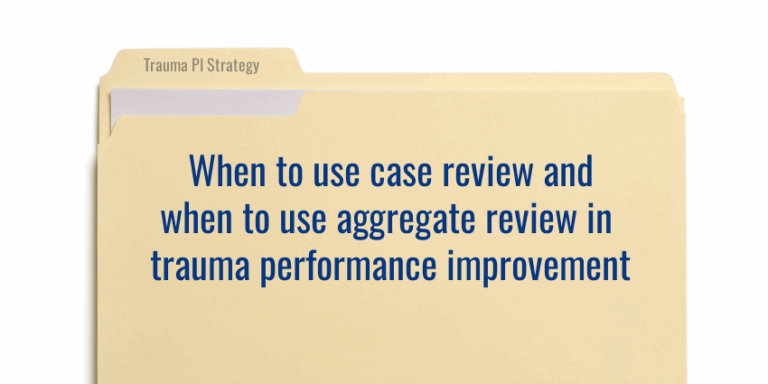One of the biggest challenges in trauma performance improvement is the sheer volume of cases that need to go through the PI process. How can trauma programs ensure effective quality review without overburdening the PI coordinator, not to mention the TPM and the TMD?
In my experience, the key is to use the right mix of case-specific review and aggregate review.
I explained this approach in detail during our April 2025 webinar, Trauma PI Strategy: Leveraging “Case Review vs. Aggregate Review” for More Efficient Loop Closure.
In this article, I want to summarize the main points of this PI strategy, share some practical advice and also address some potential sources of confusion.
But before I dive in, one quick note: I do not represent the American College of Surgeons (ACS) in any capacity. This article is based solely on what I have learned while helping trauma centers nationwide achieve ACS compliance. Trauma program leaders should always refer to the ACS and/or their state’s designating body for official guidance on the standards and the site review process.
Definition of case review and aggregate review
Let’s begin with some basic definitions:
Case review is the detailed examination of a single patient record to identify any deviations from the standard of care. The purpose of this review is to identify care issues that may have contributed to an adverse event or an unexpected outcome.
Aggregate review is the use of performance data to examine a group of related cases. The purpose is to identify adverse trends, explore deviations from benchmark performance, or assess the effectiveness of care guidelines and protocols.

Which review method is best? The fact is that each method has both pros and cons.
The main benefit of case review is that it lets trauma program leaders identify care deviations precisely. For example, for a patient with an unplanned return to the ICU, a careful case review could determine the exact practices that may have contributed to this event. In addition, case review can allow trauma program leaders to correct quality issues while the patient is still in the hospital and deliver feedback to clinicians in a timely manner.
However, case review also has drawbacks. Since it is focused on single cases, the findings can reflect the bias of the reviewer. In addition, single-case review can miss larger trends and lead to multiple inconsistent action plans. Finally, case review is resource-intensive, so it can be difficult to manage in high-volume centers.
Turning to aggregate review, let’s begin with the cons: First, aggregate review depends on data — so to the extent that a trauma registry is inaccurate and/or incomplete (which can be attributed to inadequate or incomplete documentation in the EMR), the results of aggregate review will be skewed. In addition, aggregate review in itself will not uncover important facts (for example, failure to follow care guidelines) that can lead to an adverse outcome. And since aggregate review is always a look-back at months or years of data, any beneficial impact will always be delayed.
However, the benefits of aggregate review are significant. First, aggregate review allows trauma program leaders to assess total outcomes and tackle the system issues that can have a huge effect on patient care. Aggregate review also allows teams to analyze a large number of cases very efficiently.
Taking all the pros and cons together, my overall recommendation is to:
- Perform case review only for cases that stand out as a concern based on a poor or unexpected outcome or another known or suspected problem.
- Use aggregate review to monitor the entire trauma program for potential quality issues.
But don’t we have to review every patient record?
Whenever I talk about using aggregate review versus case review, people ask, “But don’t we have to review every case for opportunities for improvement?”
To answer this question, we should first understand that there is no expectation in ACS standards that the PI coordinator or anyone else must perform a case review, much less a case summary, on every single patient record.
While it is true that Standard 7.2 lists more than two dozen audit filters and events that must be included in the written PIPS plan, it does not specify any particular method for reviewing these events. In fact, the standard states that the PIPS plan must clarify “[w]hich cases are to be reviewed” for each level of review. This wording implies that case review can and should be used selectively.
Having said that, I understand that some state designating authorities require PI coordinators to review every case, so be sure to check your state regulations to understand the requirements that apply to your trauma center.

Looking beyond the requirements, remember that the underlying purpose of trauma PI is to reduce unnecessary variation in care and prevent adverse events. By definition, reducing variation in care is achieved by monitoring for variances against established standards and best practice guidelines. This, in turn, can be accomplished both by reviewing specific cases and by analyzing aggregate data.
In other words, an effective trauma PI program will incorporate both case review and aggregate review.
When to use case review
In general, perform case-level review for all:
- Cases with an adverse outcome, including mortalities, significant complications and any unexpected outcome for the patient
- Complex cases involving multiple specialties or with an extended course of care
- Cases involving an area of concern that needs concurrent surveillance, such as full trauma activations, ICU admissions, IR cases and “time to OR” issues
- Cases with potential provider concerns that may require peer review
For PI coordinators, one of the best ways to identify patients for case review is simply to be present at trauma activations. Other effective strategies are attending morning hand-offs and trauma rounds. (For more recommendations, see the “event identification” bullet point of Standard 7.2.)
One underappreciated approach is to train trauma registrars to be “on alert” for variances in care as they abstract records. The registry team looks at every patient that comes through your program, so if you educate them on the issues you are looking for, they will catch nearly all cases of potential concern.
I noted above that case-level review is resource-intensive. To streamline the case review process, create an outline of the key information that the TMD would like to see in every summary. (See below for one possible approach.) Organizing information in this way will simplify primary review and help make sure other levels of review proceed as quickly as possible.
Sample Case Summary
| PI event/issue | Reason(s) for review: (death, unplanned ICU admission, etc.) |
| Patient info | Case summary: (brief summary of relevant information) Age: Date and time of injury: MOI: |
| Prehospital info | Mode of transport to hospital: (EMS, HEMS, PV) Prehospital vital signs: (highest HR, lowest BP, highest & lowest GCS) Prehospital findings and interventions as appropriate: |
| ED info | Date and time of arrival to ED: Team activation level or statement of no activation: Initial VS: Findings and interventions in ED as appropriate: Time of consults: (including time notified and time at bedside) Plan of care: (e.g., to OR with ortho for operative fixation) Time of departure from ED and destination: (CT, IR, OR, ICU, floor) |
| ED disposition | Time of arrival to destination: (CT, IR, OR, ICU, floor) VS on arrival: Plan of care: |
| Hospital stay summary | Summary of relevant hospital events: (e.g., DVT prophylaxis started on HD 1, DVT identified on HD 3, changed to therapeutic) Final disposition: (date and location, e.g., home, SNF, LTAC, death) |
| Level of review summary | Secondary review comments: Tertiary review discussion: Determination: (event with or without OFI) Judgment: (system, provider, disease) Recommended actions and planned follow-up: |
When to use aggregate review
In general, PI staff should perform aggregate review to monitor and assess:
- Trends and patterns across multiple cases (for example, all cases with a non-surgical admission)
- The effectiveness of guidelines and care protocols (for instance, program performance against agreed-upon MTP guidelines)
- System issues (such as undertriage and overtriage rates)
- Performance against benchmarking data (any outliers within your TQIP report)
The most effective tool for managing aggregate review is a quality dashboard. With the right audit filters, the dashboard will spotlight performance issues and “flash red” until you fix them.
Your SBIRT (Screening, Brief Intervention and Referral to Treatment) process is a good example of a PI issue that is best handled through aggregate review. Attempting to analyze and follow up on every case with a missing intervention or referral is not sustainable. Instead, use data analysis to look at the trends.
For instance, your high-level analysis may show that your screening rates are compliant, but you are lagging in actual interventions and referrals. Use an improvement methodology such as Plan-Do-Study-Act (PDSA) to tackle this OFI at the team process level.
Another example is trauma flowsheet documentation. A PI coordinator who confronts staff about every missed temperature will soon wear out their team and themself. Use data reports to assess documentation compliance trends and address any shortfalls via team education.
A few PI pearls
Exploring different ways to use case review versus aggregate review underscores the fact that trauma performance improvement is both a science and an art. With that in mind, here are a few pearls that can help PI professionals find the right balance between the two.
Do not chase 100% compliance. Once you have demonstrated 80% compliance (for example, with SBIRT), declare victory and move on to another issue. Continue to monitor performance via your quality dashboard to verify ongoing compliance, but do not exhaust yourself and the trauma team trying to attain a “perfect” score.
Put “timeliness” in perspective. In general, site reviewers expect a center’s performance improvement process to be timely. However, the ACS standards do not define “timeliness” for PI. The fact is that many issues take several months (and sometimes years) to resolve. In practice, timeliness refers to the timely identification of a problem and the prompt development of an action plan to resolve it. So if your program is successful at recognizing issues within a reasonable time frame (e.g., 60 days) and promptly creating corrective action plans, you can be assured that your PI efforts are timely.
Note: Some states have established regulations defining timely PI review, such as “primary review must be completed within 14 days of discharge”. It is important to know your state’s requirements as well as your own limitations due to staffing constraints and patient volumes. My advice is to discuss these issues with your state contacts and come to an understanding of what your state reviewers will expect regarding PI review timeframes.
Before changing your process, check your software. Any discussion of trauma PI review should note that the Society of Trauma Nurses has recently updated the TOPIC course with new content. At this point, however, most PI software systems have not been updated to any new TOPIC recommendations. PI coordinators and TPMs should review their software capabilities before adopting any new strategies for documenting PI review.
Your action plan is not loop closure. Whether you are tackling an issue through case review or aggregate review, it is important to recognize that creating a corrective action plan is not the same as closing the loop. To truly close the loop on a PI issue, you must demonstrate that your corrective action has been effective. How do you do that? The short answer is compliance auditing, which is a systematic approach to measuring and monitoring performance. (To learn more, read How to use compliance auditing to demonstrate trauma loop closure.)
Focus on what matters. Trauma PI is a complex endeavor that involves multiple processes, priorities, methods and tools. However, in my experience, a lot of the confusion around trauma PI melts away when you stay focused on the goal — improving patient outcomes. Maintaining this focus will help you de-emphasize low-value work and concentrate instead on PI activities that have a strong chance of benefiting future patients.
Angie Chisolm, MBA, BSN, RN, CFRN, TCRN is a nationally recognized expert in trauma program operational efficiency, coding and billing, site survey readiness and performance improvement. Angie is also president and managing partner of Optimal Healthcare Advisors.

